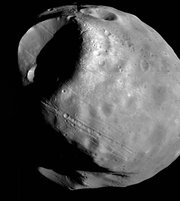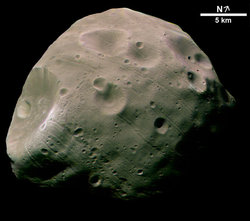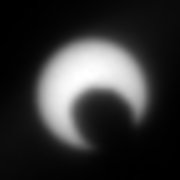Phobos (moon)
|
|
| Phobos as imaged by Mars Express on August 22, 2004. The large crater on the lower left of the image is Stickney. | |
| Discovery | |
|---|---|
| Discovered by | Asaph Hall |
| Discovered on | August 18, 1877 |
| Orbital characteristics (Epoch J2000) | |
| Mean radius | 9377.2 km 1 (http://exp.arc.nasa.gov/downloads/celestia/data/solarsys.ssc) |
| Circumference | 58,915 km |
| Eccentricity | 0.0151 |
| Periapsis | 9235.6 km |
| Apoapsis | 9518.8 km |
| Revolution period | 0.318 910 23 d (7 h 39.2 min) |
| Avg. Orbital Speed | 2.138 km/s |
| Inclination | 1.075° (0.046° to local Laplace plane) |
| Satellite of | Mars |
| Physical characteristics | |
| Mean diameter | 22.2 km (26.8 × 21 × 18.4) (0.0021 Earths) |
| Oblateness | 0.31-0.12 |
| Surface area | 6,084 km² (11.9 µEarths) |
| Volume | 5,422 km3 (5.0 nEarths) |
| Mass | 1.07 × 1016 kg (1.8 nEarths) |
| Mean density | 1.9 g/cm³ |
| Surface gravity | 0.0084 - 0.0019 m/s² (8.4-1.9 mm/s²) (860-190 µg) |
| Escape Velocity | 0.011 km/s (11 m/s) |
| Rotation period | synchronous |
| Rotation velocity | 11.0 km/h (at the longest axis' tips) |
| Axial tilt | 0° |
| Albedo | 0.07 |
| Surface temp. | ~313 K |
| Atmospheric pressure | no atmosphere |
Phobos (foe'-bus, Greek Φόβος) is the larger and innermost of Mars' two moons, named after Phobos, son of Ares (Mars) from Greek Mythology. Phobos orbits closer to a (major) planet than any other moon in the solar system, less than 6000 km above the surface of Mars. It is also one of the smaller known moons in the solar system. It has been designated Mars I.
| Contents |
Discovery
Phobos was discovered by American astronomer Asaph Hall on August 18, 1877 at the US Naval Observatory in Washington, D.C at about 09:14 GMT (contemporary sources, using the pre-1925 astronomical convention that began the day at noon, give the time of discovery as "August 17 16:06" Washington mean time). [1] (http://adsabs.harvard.edu//full/seri/AN.../0091//0000014.000.html). Asaph Hall also discovered Deimos.
The names were suggested by Henry Madan (1838–1901), Science Master of Eton, from Book XV of the Iliad, where Ares summons Fear and Fright.
Phobos was photographed close-up by Mariner 9 in 1971, Viking 1 in 1977, Phobos 2 in 1988, Mars Global Surveyor in 1998 and 2003, and by Mars Express in 2004 .
Orbital characteristics
Phobos_Deimos_orbit_Mars.jpg
Phobos orbits Mars below the synchronous orbit radius, meaning that it moves around Mars faster than Mars itself rotates. Thus it rises in the west, moves comparatively rapidly across the sky (in 4 h 15 min or less) and sets in the east, approximately twice a day (every 11 h 6 min). It is so close to the surface (in a low-inclination equatorial orbit) that it cannot be seen above the horizon from latitudes greater than 70.4°.
This low orbit means that Phobos will eventually be destroyed: tidal forces are lowering its orbit, currently at the rate of about 1.8 metres per century, and in about 50 million years it will either impact the surface of Mars or (more likely) break up into a planetary ring. Given Phobos' irregular shape (intermediate between a prolate and oblate spheroid) and modeling it as a pile of rubble (specifically a Mohr-Coulomb body), it has been calculated that Phobos is stable with respect to tidal forces, but it is estimated that Phobos will pass the Roche Limit for a rubble pile of its description when its orbital radius drops to about 8400 km, and will likely break up soon afterwards 1 (http://keith.aa.washington.edu/papers/icarus2001.pdf). Because of its ellipsoidal shape alone, the gravity on Phobos' surface varies by about 210%; the tidal forces raised by Mars more than double this variation (to about 450%) because they compensate for a little more than half of Phobos' gravity at its sub- and anti-Mars poles.
As seen from Phobos, Mars would be 6400 times larger and 2500 times brighter than the full Moon as seen from Earth, taking up a full 1/4 of the width of a celestial hemisphere.
As seen from Mars' equator, Phobos would be one-third the angular diameter of the full Moon as seen from Earth. Observers at higher Martian latitudes (less than the 70.4° latitude of invisibility) would see a smaller angular diameter because they would be further away from Phobos. Phobos' apparent size would actually vary by up to 45% as it passed overhead, due to its proximity to Mars' surface. For an equatorial observer, for example, Phobos would be about 0.14° upon rising and swell to 0.20° by the time it reaches the zenith. By comparison, the Sun would have an apparent size of about 0.35° in the Martian sky.
Physical characteristics

Phobos is a dark body that appears to be composed of C-type surface materials. It is similar to the C-type (blackish carbonaceous chondrite) asteroids that exist in the outer asteroid belt. Phobos's density is too low to be pure rock, however. It is probably composed of a mixture of rock and ice. The Soviet spacecraft Phobos 2 detected a faint but steady outgassing from Phobos. Unfortunately Phobos 2 failed before it could determine the nature of the material, but it is most likely water. Recent images from Mars Global Surveyor indicates that Phobos is covered with a layer of fine dust about a metre thick, similar to the regolith on the Earth's Moon.
Phobos is highly nonspherical, with dimensions of 27 × 21.6 × 18.8 km. It is heavily cratered. The most prominent feature on Phobos is the large crater named Stickney, the maiden name of Asaph Hall's wife Chloe Angeline Stickney Hall. Like Mimas's crater Herschel on a smaller scale, the impact that created Stickney must have almost shattered Phobos. The grooves and streaks on the surface were probably also caused by the Stickney impact. The grooves are typically less than 30 m deep, 100 – 200 m wide, and up to 20 km in length.
Phobos is widely believed to be a captured asteroid. There is some speculation that it originated in the outer solar system rather than in the main asteroid belt.
References
Contemporary accounts of the discovery of Phobos and Deimos:
- The Observatory, 1 (1877) 181 (http://adsabs.harvard.edu//full/seri/Obs../0001//0000181.000.html)
- Astronomische Nachrichten, 91 (1878) 13/14 (http://adsabs.harvard.edu//full/seri/AN.../0091//0000014.000.html)
- Monthly Notices of the Royal Astronomical Society, 38 (1878) 205 (http://adsabs.harvard.edu//full/seri/MNRAS/0038//0000205.000.html)
- Astronomische Nachrichten, 92 (1878) 47/48 (http://adsabs.harvard.edu//full/seri/AN.../0092//0000031.000.html)
See also
- Deimos, the other moon of Mars
- List of features on Phobos and Deimos
- Transit of Phobos from Mars
- Shadow of Phobos on Mars
External links
- Flight around Phobos (http://www.star.ucl.ac.uk/~idh/solar/cap/mars/vphobos3.htm) (animated movie)
- Animation of Phobos (http://www.star.ucl.ac.uk/~idh/solar/cap/mars/vphobos2.htm)
| Our Solar System |
| Sun | Mercury | Venus | Earth (Moon) | Mars | Asteroid belts |
| Jupiter | Saturn | Uranus | Neptune | Pluto | Kuiper belt | Oort cloud |
| See also astronomical objects and the solar system's list of objects, sorted by radius or mass |
de:Phobos (Mond) es:Fobos (luna) eo:Fobo fa:فوبوس fr:Phobos (lune) it:Phobos (luna) he:פובוס (ירח) nl:Phobos (maan) ja:フォボス (衛星) no:Phobos nn:Marsmånen Phobos pl:Phobos pt:Fobos fi:Phobos sv:Phobos (måne) uk:Фобос (супутник) zh:火卫一


